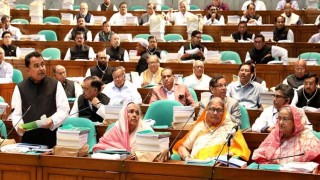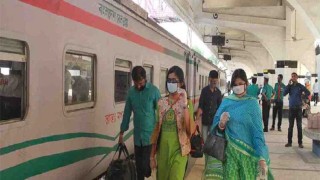National Nutrition Week: In The Cradle Of Hope And Despair
25 April 2022, 01:01 pm | Updated: 27 February 2025, 07:36 pm

Some 47 years back, in 1974, under the leadership of Father of the Nation Bangabandhu Sheikh Mujibur Rahman, 'Public Health Nutrition Institute' was established as part of institutional development to ensure nutrition of the people. Following this, on 23 April 1975, Bangabandhu formed the 'Bangladesh National Nutrition Council' which is his groundbreaking institutional contribution in the arena of nutrition. After a long hiatus, the National Food and Nutrition Policy and the first Bangladesh National Nutrition Action Plan were formulated in 1997 and since 1998, the Council has been observing National Nutrition Week every year at national, district and upazila level [1]
However, after the death of Bangabandhu, the Nutrition Council suffered a setback – which again started to coming back to life in this day and age, yet it is necessary to evaluate how efficient the National Nutrition Council is according to the needs of the people, and whether the government has provided sufficient manpower together with the resource to effectively serve its purpose.
With this years’ theme “proper nutrition for healthy life”, Bangladesh is celebrating National Nutrition Week from 23rd to 29th April 2022, and this is the time to look back at both our successes and failures to move forward.
First of all, those who have decided the theme deserve to be acknowledged for identifying the right concern. Bangladesh suffers from both the overnutrition and malnutrition: about 70% of the total deaths in this country are due to non-communicable diseases which are caused by malnutrition or eating habits, in reverse more than half of our women are suffering from nutritional anemia. Under such a setting, the celebration of National Nutrition Week should not only emphasize on the formalities of commitment, rather on taking home the success of these policies implementation. Besides, assessment is crucial of these policies that the council has developed and implemented in the last few years.
If we look back at the success of nutrition, the malnutrition and mortality rate of children has decreased in recent years. Bangladesh has also made great strides in education and food production. However, according to the Bangladesh Demographic and Health Survey (BDHS) 2017-18, 30% of children under the age of five have a lower height ratio compared to their weight and 8% a lower weight ratio compared to hight: which is still much higher [2]. On the other hand, according to MICS Survey 2019, this rate is 28% and 10% respectively. Furthermore, Bangladesh Adolescent Health and Wellbeing Survey 2019-20 reflects that, approximately one-third of adolescent female and one-fifth of adolescent male are malnourished. The survey also found that one in ten unmarried teenagers is underweight and another one in ten is overweight. Among married adolescents and women, 4% were underweight and 16% were overweight. In addition, about 76% -85% of adolescents had adequate dietary variation with (70% -78%) iron-rich foods, whereas only one-fourth of them consume foods rich in vitamin A [4].
Conversely, from 2004 to 2016, the underweight children decreased from 39.53% to 30.96% whereas, in the same point of time, the prevalence of overweight / obesity among adolescent girls has increased from 1.69% to 11.40% [5]. According to BDHS 2017-18, 79% of children aged 6-59 months took vitamin A supplement which seems to have increased from 62% compared to data presented in BDHS 2014. The World Nutrition Report says there has been limited progress in achieving the Non-Communicable Diseases (NCD) target and nearly no progress towards the goal of obesity, despite the fact that approximately 6.2% of adult (18 years of age) women and 3.0% of adult man are obese in Bangladesh [6]. Experts opined that the use of processed foods has increased, leading to a highway to obesity and non-communicable diseases. The food provided in the residential dormitories of schools, colleges and universities is of poor in quality. Students and parents discern this as a situation that has been continuing for ages, and no steps are being taken to overcome it.
On a different note, patients in different countries are sent to the nutritionist for proper diet management when they visit doctors for treatments, but in our country, there is no such system neither are any guidelines to for nutritional consultation. Experts fears if this continues, the real purpose of Integrated Nutrition Programme would remain unachieved. At present there is an acute shortage of manpower to control the rate at which food adulteration has increased. We regularly feed our children packaged foods that compliment poor health outcomes. Here, regretfully, the SUN Civil Society has been formed to speak on behalf of the people, but it seems to interplay with the interests of the nutrition traders. O'er, experts say that most of the nutrition research in Bangladesh have been done in paper but in reality, hence, their reflection do not influence the relevant initiatives and existing scenario. Along with the Ministry of Health, 21 other ministries are involved in nutrition-related activities, yet there lies a lack of inter-ministerial coordination.
Ministry of Health cannot alone make the difference, rather the expected development requires multisectoral approaches and integrated responsibility for the implementation of nutrition activities. Anyway, it is also important to involve other ministries in the celebration of this Nutrition Week. We hope that the government will take into account issues like COVID-19 subsequent malnutrition, market control and good governance, etc. Lastly, mindfulness of poor and underprivileged people, all the success is wished for the National Nutrition Week, 2022.
Dr. Shamim Talukder: Chief Executive Officer, Eminence Associates for Social Developemt
Reference
1. বাংলাদেশ জাতীয় পুষ্টি পরিষদ কার্যালয়. (n.d.). Retrieved April 23, 2022
2. National Institute of Population Research and Training (NIPORT), Mitra and Associates, ICF International. Bangladesh Demographic and Health Survey 2017-18. Dhaka, Bangladesh and Calverton, Maryland, USA: 2020
4. National Institute of Population Research and Training (NIPORT), International Centre for Diarrhoeal Disease Research, Bangladesh (icddr,b), and Data for Impact. (2021). Bangladesh Adolescent Health and Wellbeing Survey 2019-20: Final Report. Dhaka, Bangladesh, and Chapel Hill, NC, USA: NIPORT, icddr,b, and Data for Impact.
6. Country Nutrition Profiles. [cited 23 Apr 2022]
SA/





















